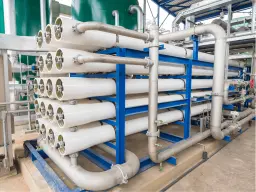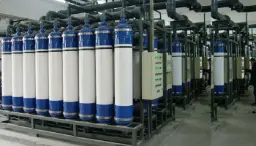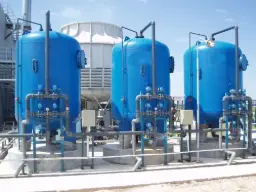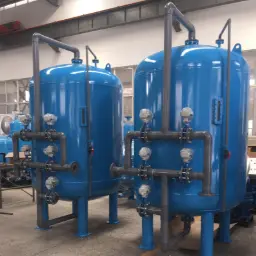Dyeing and Printing Processes
Producing vibrant, wash-fast fabrics hinges on far more than the quality of dyestuffs alone. In a modern textile mill, vast volumes of water interact with fibers, auxiliaries, and colorants during dyeing and printing, so the make-up water entering jet machines, jiggers, continuous ranges, or rotary screen printers must arrive at a tightly controlled purity. Dye baths that contain hidden bicarbonate alkalinity, residual chlorine, or a few parts per million of hardness can shift shade, dull fluorescence, or generate speckled appearance on finished goods. When chlorinated city water strikes reductive vat dyes, unfashionable brown tones creep in; when high conductivity strikes reactive dyes, exhaustion efficiency drops, sending chemical oxygen demand soaring in the effluent. Consequently, dye houses depend on integrated water-treatment trains that transform inconsistent municipal or well sources into a predictable, “textile-grade” utility that preserves hue and hand while reducing re-dye rejects.
Dyeing and printing processes therefore represent a water-intensive branch of the textile industry, converting greige fabric into value-added fashion through a sequence of scouring, bleaching, dye application, fixation, and post-wash steps. Water enters at almost every node, from enzyme scours that rinse cotton waxes to post-printing soaping that strips unfixed dye. What practitioners mean by “dyeing and printing water treatment” is the provision of softened, dechlorinated, deionized, or otherwise conditioned water that stabilises liquor ratios, improves dye uptake kinetics, and protects high-pressure dyeing equipment from scale. Unlike boiler feed or cooling water, the central objective is not corrosion control but shade reproducibility, so the design emphasis skews toward removing polyvalent cations, oxidants, colour bodies, and dissolved solids that meddle with dyebath chemistry.
Related Water Systems for Dyeing and Printing Processes
Carefully engineered combinations of physical, chemical, and membrane technologies stand between raw intake and the precision requirements of reactive or disperse dyes. Their sequence and redundancy depend on local raw water traits, production scale, and shade-sensitive product lines such as sportswear or automotive fabrics. Continuous automatic operation, rapid recipe changes, and tight enclosure around color kitchens push designers toward compact skid modules that integrate sensors, remote valves, and batch blending tanks for final liquor adjustment. At the same time, sustainability targets push mills to recover heat, regenerate membranes with low-impact chemicals, and recycle a growing fraction of rinse water through side-stream loops.

Reverse Osmosis
Thin-film composite membranes reject up to 98 % of dissolved salts, silica, and small organic molecules, yielding permeate with conductivity below 15 µS cm-¹ that serves as the base for high-shade-consistency dye liquors.

Ultrafiltration
Hollow-fiber UF barriers capture colloids, bacteria, and macromolecular color bodies, extending RO membrane life and preventing printing screen nozzle clogging when permeate is looped into wash boxes.

Activated Carbon Filtration
Granular media strips residual chlorine, chloramines, and odorous organics, preventing oxidative attack on vat dye reducing agents and preserving enzyme activity in bio-scours.

Deionization
Cation and anion resin beds exchange hardness ions, bicarbonate, and sulfate for hydrogen and hydroxide; they produce near-neutral water that protects shades sensitive to divalent metals while offering higher flow turndown than RO alone.
The combination of these units attacks every impurity class that destabilises dyeing chemistry: divalent metals that chelate reactive dyes, oxidants that quench vat reducers, colloids that block jet gaps, and dissolved solids that swing liquor pH. Deploying them in a thoughtfully validated train ensures each downstream stage receives feedwater with predictable mineral and organic loading, reducing batch-to-batch shade deviation and driving first-pass quality above 95 %.
Key Water-Quality Parameters Monitored
Consistency begins with measurement. Textile technologists track a suite of physico-chemical parameters that map directly to color yield and fabric handle. Electrical conductivity, for instance, serves as a proxy for total dissolved solids; when it rises above 120 µS cm-¹ in a reactive dye bath, hydrolysis accelerates, costing fixation efficiency. Hardness below 2 mg L-¹ as CaCO₃ is imperative for disperse dyes on polyester, because calcium bridges drive dye agglomeration that manifests as specks on finished fabric. Turbidity influences roller printing by lodging particulate soils under doctor blades, while silica above 5 mg L-¹ can crystallise on high-stretch elastane yarns during heat-set, leading to abrasive white streaks.
Operators also monitor pH drifts, residual oxidants, bacterial counts, and total organic carbon to protect enzymes and prevent slime in low-temperature wash tanks. Dye machines equipped with online colorimeters detect minute shade drifts, but without stable feedwater even the best closed-loop control struggles. Water-quality sensors integrated into SCADA platforms stream data to predictive algorithms that model how influent variability would impact upcoming dye recipes, letting planners reroute high-TDS water to less sensitive dark shades or initiate an RO batch ahead of peak demand.
| Parameter | Typical Range | Control Method |
|---|---|---|
| Conductivity | 5-30 µS cm-¹ | RO or EDI set-point control |
| Total Hardness | < 2 mg L-¹ as CaCO₃ | Softener regeneration or RO |
| pH | 6.0-7.0 | CO₂ stripping, caustic dosing |
| Residual Chlorine | < 0.05 mg L-¹ | Activated carbon or sodium bisulfite quench |
| Silica | < 5 mg L-¹ | RO plus magnesium oxide trap |
| Turbidity | < 0.3 NTU | UF backwash optimisation |
| Total Organic Carbon | < 1 mg L-¹ | Ozone oxidation, biologically active carbon |
| Iron & Manganese | < 0.02 mg L-¹ combined | Greensand filtration, RO |
| Bacterial Count | < 100 CFU mL-¹ | UV disinfection, ozone residual |
| Temperature Variation | ± 1 °C | Heat exchanger PID loops |
Design & Implementation Considerations
Building a dyeing water-treatment plant starts with a granular mass balance that reconciles recipe-based peak demand, counter-current wash loops, and discharge limits. Engineers size membrane racks so that 80 % of cleaning-in-place downtime can occur during night shifts, preserving daytime reliability. Pipework must resist bleaching chemicals and high-temperature dye liquors, so designers choose stainless AISI-316L or polypropylene random (PP-R) depending on pressure class and budget. Precision pH control often demands inline static mixers ahead of dye bath make-up tanks, and PLC logic sequences interlocks to prevent caustic slug dosing that could precipitate vat dyes.
Factory 4.0 initiatives introduce digital twins to simulate fouling rates under differing fiber blends, anticipating when to swap resin beds or tune antiscalant dosage. Energy recoverers on RO concentrate allow steam boiler makeup to reclaim latent heat, shaving over 1 kWh m-³ permeate. Sustainability goals press plant owners toward zero-liquid-discharge concepts that pair two-pass RO with mechanical vapour recompression (MVR) evaporators, yielding salt for recovery and permeate for wash. Finally, new ISO 5079 traceability requires tagging batches with water footprint, so instrumentation must feed secure databases that auditors can verify.
The following chart visualises how influent conductivity propagates through each treatment stage, highlighting the polishing impact of RO-EDI integration on final dye bath purity.
Operation & Maintenance
Once commissioned, the plant relies on disciplined preventive routines that keep membranes, resins, and sensors in peak condition. Operators schedule RO clean-in-place every 400 operating hours or when normalised flux drops 10 %, alternating alkaline and acidic formulations to dislodge organics and scale. Softener resin receives counter-current regeneration with saturated brine adjusted to 10 % excess to conserve salt while preventing calcium leakage into vat dye reduction lines. Carbon beds backwash weekly to expel trapped lint, and differential pressure transmitters alarm at 0.7 bar rise, prompting media air-scour.
Digitised maintenance management systems issue work orders for UV lamp replacement after 9 000 h burn-time and verify germicidal dose via sensor feedback. Predictive analytics built on machine learning study turbidity and SDI trends to forecast fouling, allowing procurement to stage chemicals in advance. Spare part strategies keep two full sets of RO elements on site, shrink-wrapped under nitrogen, while remote service teams access PLC logs through secure VPN for troubleshooting without travel. Regular cross-checks with production lab shade cards correlate water quality excursions with reject spikes, closing the loop between utilities and textile QA.
Challenges & Solutions
Textile regions often draw from shallow wells susceptible to monsoon-driven turbidity surges, so treatment trains face seasonal load swings that can overwhelm UF modules. Antiscalant overdosing may trigger foam in jet dyeing machines, yet underdosing precipitates calcium sulfate scale inside RO vessels. Balancing salt recovery goals with membrane longevity is a constant dilemma, because aggressive permeate recovery raises concentrate osmotic pressure and fouling propensity. Energy costs climb when feedwater arrives above 30 °C, forcing higher flux derating; conversely, winter chills cut permeate flow and lengthen batch cycles.
Solutions revolve around adaptive process controls that adjust recovery ratio, cycle pH, and cleaning intervals based on real-time sensor feedback. Variable-frequency pump drives match permeate demand, shaving electricity peaks. Hybrid designs place nanofiltration ahead of RO to pre-reclaim dyestuffs, lowering load on expensive polishing membranes. Where groundwater carries silica, magnesium-enhanced lime softening upstream of RO converts colloidal silica into insoluble flocs that settle in lamella clarifiers. For mills pressed by water scarcity, advanced oxidation plus membrane bioreactors reclaim 70 % of rinse effluent, blending it with raw intake to buffer against drought.
Advantages & Disadvantages
Attaining ultra-pure water in dyeing and printing delivers commercial payback through reduced shade rework, lower chemical consumption, and streamlined wastewater treatment, yet it also introduces capital, energy, and complexity overheads. Plant managers weigh these trade-offs when budgeting new capacity or retrofitting legacy operations. The sustainability narrative increasingly shifts cost-benefit toward high-purity systems by counting product-life-cycle emissions and brand pressure for eco-labelling. Nevertheless, small job-shop dye houses with eclectic shade books may struggle to justify full EDI polishers, opting instead for partial softening plus carbon where consistency requirements are looser.
In practice, success hinges on aligning treatment depth with product portfolio: sportswear brands ordering fluorescent shades on recycled polyester demand tighter water specs than denim laundries chasing vintage effects. The table below synthesises key pros and cons to guide decision makers in matching technology to strategic goals.
| Aspect | Advantages | Disadvantages |
|---|---|---|
| Shade Consistency | First-pass yield > 95 %, reduced lab dips | Requires tight process control and staff training |
| Chemical Savings | Lower reactive dye hydrolysis, less salt dosing | Upfront CapEx for RO-EDI skid |
| Equipment Protection | Eliminates scale, prolongs jet pump seals | Membrane fouling risk if pre-treatment lax |
| Sustainability | Enables rinse-water recycling, lower COD load | Energy consumption rises at high recovery |
| Regulatory Compliance | Simplifies effluent permits via lower metals | Concentrate brine disposal needs planning |
Frequently Asked Questions
Securing buy-in from production supervisors, chemical suppliers, and sustainability officers often involves addressing recurring questions about costs, performance metrics, and integration hurdles. The following two-paragraph primer tackles industry concerns ranging from dye shade reproducibility to concentrate disposal pathways. Understanding these issues up front accelerates project timelines and aligns expectations across departments, ensuring that the water-treatment upgrade delivers measurable quality and environmental gains without derailing ongoing shift schedules. Suppliers that provide lifecycle support, pilot testing, and digital dashboards tend to achieve faster acceptance because they demystify membrane science and translate data into actionable dye-house KPIs.
Stakeholders also ask how treatment influences machine cycle times, whether softened water alone suffices for vat or sulphur dyes, and how new systems mesh with existing heat-recovery loops. Addressing corrosion compatibility, resin chemical safety, and global brands’ restricted-substances lists helps mills avoid future compliance pitfalls. Below, typical queries appear with concise engineering-level answers rooted in field experience at large and small textile complexes.
Q1: Do I still need softeners if I install reverse osmosis?
A properly designed single-pass RO unit removes > 93 % hardness, but if feedwater regularly spikes above 350 mg L-¹ as CaCO₃, a twin-bed softener upstream protects membranes and slashes antiscalant cost.
Q2: How much permeate should I allocate to bleaching versus dyeing?
Allocate the lowest-conductivity permeate (< 10 µS cm-¹) to peroxide bleaching and light-shade reactive dyeing, while higher-TDS permeate can feed scours, mercerising washers, and dark-shade vats to maximise resource efficiency.
Q3: Can I recycle printing wash water without color cross-contamination?
Yes, coupling ultrafiltration with ozone oxidation reduces color to < 50 Pt-Co units, allowing 60-70 % recycle for washing off rotary screens, provided a 2 h hydraulic residence buffer balances tone carryover.
Q4: What is the typical payback period for RO-EDI upgrades?
In medium-scale knit fabric mills, CAPEX recovery averages 24-30 months, driven by a 3-5 % reduction in re-dye, lower salt loading to effluent plant, and 15 % chemical savings.
Q5: How do I handle RO concentrate in water-scarce regions?
Options include evaporative ponds with salt harvesting, mechanical vapour recompression crystallisers for near-zero liquid discharge, or blending with high-salinity cooling tower bleed where regulations permit.
Q6: Will high-purity water alter fabric handle?
No, handle primarily depends on mechanical finishing and lubricant residuals; pure water simply ensures auxiliaries work as intended without precipitating on fibers.
Q7: How often should I calibrate online conductivity sensors?
Monthly lab cross-checks suffice under ISO 9001, though critical EDI polishers may demand weekly verification using traceable 1413 µS cm-¹ standards.